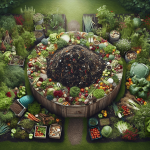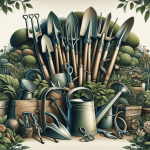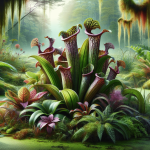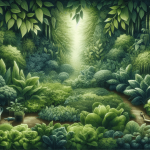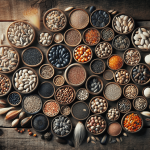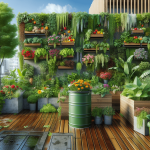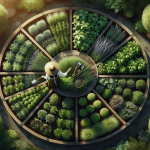This post may contain affiliate links. As an Amazon Associate, we may earn commissions from qualifying purchases.
How can I design a garden that provides year-round interest?
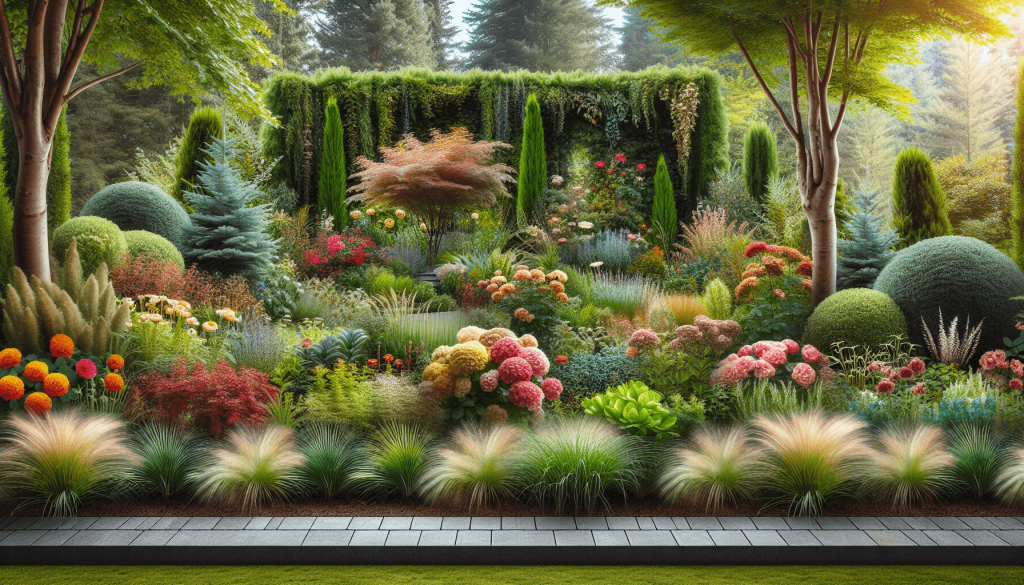
Introduction
Have you ever looked out at your garden in the middle of January and thought, “Is that it?” You might have lush green in spring and a riot of colors in summer, but what about the rest of the year? Designing a garden that provides year-round interest is like creating a four-course meal, each season offering its own unique flavors and textures.
Creating a garden that captivates throughout all seasons involves meticulous planning, a variety of plants, and an eye for design. Let’s break it down so you can have a garden that keeps giving, no matter the time of year.
Understanding Your Climate
Before you even pick up a spade, understanding your local climate is key. Different plants thrive under varying conditions. Are you in a Zone 5 with frosty winters or a Zone 10 where it’s practically summer year-round?
USDA Hardiness Zones
Knowing your USDA Hardiness Zone helps you choose plants suited to your climate. For instance, tulips flourish in colder climates, while Cactus laughs in the face of frost.
| Zone | Minimum Temperature (°F) | Suitable Plants |
|---|---|---|
| 3 | -40 to -30 | American Persimmon, Ponderosa Pine |
| 5 | -20 to -10 | Lilac, Hosta |
| 10 | 30 to 40 | Bougainvillea, Bird of Paradise |
Planning and Design
A beautiful garden doesn’t just happen; it’s planned. Start with a sketch, noting sun exposure, existing structures, and soil conditions. Think of your garden as a living room—zones or areas with different “furniture” for various activities and aesthetics.
Creating Garden Rooms
You wouldn’t put your dining table next to your bed, would you? Similarly, segregate the garden into areas for dining, play, and solitude. Use hedges, fences, or pathways to define these spaces.
Layering
Layering plants is like dressing in layers: you have your core pieces, and then you add accessories. Start with the taller plants in the back like ornamental trees and work your way down to ground covers.
Seasonal Interest
The goal is to have your garden reflect the four seasons like a well-curated Instagram feed. Here’s how to break it down:
Spring
Spring is all about renewal and bursting colors. Think bulbs like daffodils and tulips, which you plant in the fall. Early-bloomers like forsythia and magnolias also make the list.
Must-Have Spring Plants
| Plant | Type | Color |
|---|---|---|
| Tulips | Perennial Bulb | Various |
| Forsythia | Flowering Shrub | Yellow |
| Magnolia | Deciduous Tree | Pink, White |
Summer
Summers are vibrant and full of life. Roses, hydrangeas, and sunflowers can offer bold colors and textures. Don’t forget perennials like lavender, which also add fragrance to your garden.
Must-Have Summer Plants
| Plant | Type | Color |
|---|---|---|
| Roses | Perennial Shrub | Various |
| Hydrangeas | Flowering Shrub | Blue, Pink |
| Sunflowers | Annual | Yellow, Red |
Fall
As leaves turn golden, so should your garden. Fall-bloomers like asters, chrysanthemums, and ornamental grasses add both color and texture. Don’t forget trees like maples that provide spectacular autumn foliage.
Must-Have Fall Plants
| Plant | Type | Color |
|---|---|---|
| Asters | Perennial | Purple, Pink |
| Chrysanthemums | Perennial | Yellow, Red |
| Ornamental Grasses | Perennial Grass | Brown, Golden |
Winter
Winter gardens don’t have to be dull. Evergreens, shrubs with colorful berries, and trees with interesting bark can keep your garden lively. Think holly, red twig dogwood, and birch trees.
Must-Have Winter Plants
| Plant | Type | Color |
|---|---|---|
| Holly | Evergreen Shrub | Green, Red Berries |
| Red Twig Dogwood | Deciduous Shrub | Red Stems |
| Birch Trees | Deciduous Tree | White Bark |
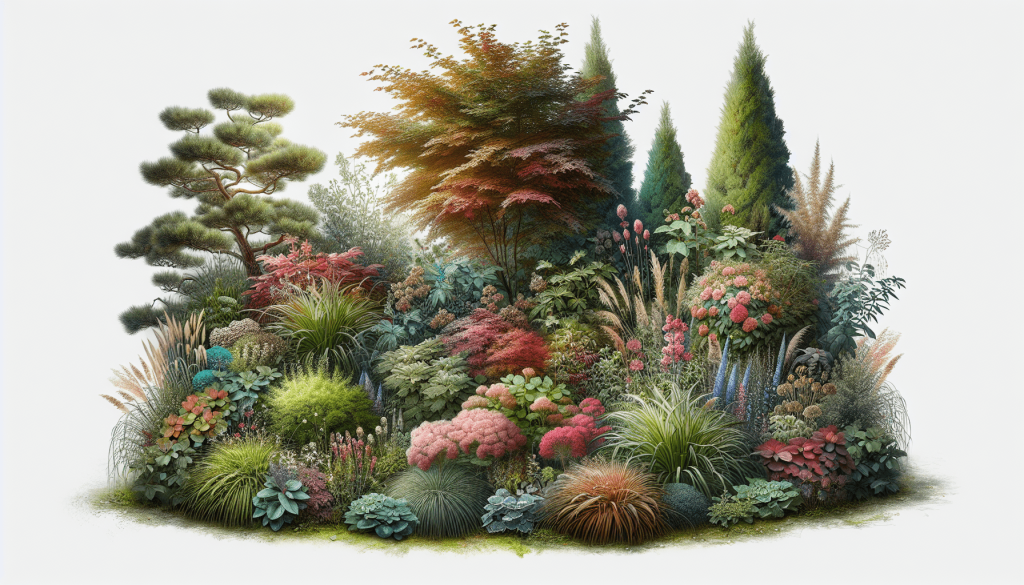
Structural Elements
Plants aren’t the only heroes here. Hardscaping—your paths, benches, and fountains—plays a significant role in creating interest.
Pathways
Pathways guide folks through your garden, making it an adventure rather than a quick stroll. Use materials like gravel, bricks, or stepping stones for variety.
Water Features
The sound of water can be soothing and masks unwanted noise. Fountains, ponds, or even a simple birdbath can enhance your garden’s appeal.
Seating Areas
A garden isn’t just to be looked at; it’s to be lived in. Place benches, swings, or even hammocks at strategic points for relaxation.
Maintenance
The best gardens are those you enjoy maintaining. Each plant and structure requires different care. Regular pruning, fertilizing, and seasonal clean-ups can make a world of difference.
Tools for the Job
Having the right tool for the job can make garden maintenance a breeze. Essential tools include pruners, a wheelbarrow, and a garden hose with a good sprinkler system.
Seasonal Chores
Break down tasks by season so they don’t feel so overwhelming. For example, spring could be for planting, summer for weeding, fall for mulching, and winter for protecting plants.
| Season | Chore |
|---|---|
| Spring | Planting, Fertilizing |
| Summer | Weeding, Watering |
| Fall | Mulching, Pruning |
| Winter | Protecting, Planning |
Pollinator-Friendly Plants
Designing a garden for year-round interest is also about creating an ecosystem. Pollinator-friendly plants like lavender and bee balm can attract beneficial insects and birds, adding to your garden’s vitality.
Feeding the Pollinators
Certain plants provide food for pollinators in every season. For example, early spring bulbs support bees just waking up, while late-blooming asters keep them full as they prepare for winter.
| Season | Pollinator Plant |
|---|---|
| Spring | Hyacinths, Crocus |
| Summer | Lavender, Coneflowers |
| Fall | Sedum, Goldenrod |
| Winter | Helleborus, Winter Jasmine |
Final Touches
Lastly, don’t forget the small touches that give your garden personality. Garden statues, whimsical tchotchkes, or even a well-placed birdhouse can make your garden uniquely yours.
Lighting
Outdoor lighting can transform your garden into a magical space even after the sun sets. Use solar lights along pathways or hang string lights in trees for a cozy, inviting atmosphere.
Décor Elements
Think of garden décor as the earrings and necklace to your outfit. Small statues, wind chimes, and garden signs can add a touch of whimsy and personal flair to your garden.
Conclusion
Designing a garden that provides year-round interest isn’t just for the avid gardener—it’s for anyone who wants a touch of magic outside their window, regardless of the season. With a little planning, some seasonal plants, and a mix of both soft and hard elements, your garden can be a continuous source of joy and inspiration. Intentionally choosing plants and features that flower, fruit, or otherwise provide visual interest in different seasons ensures you won’t look outside in January and think “Is that it?” Instead, each glance will offer something new and delightful.

